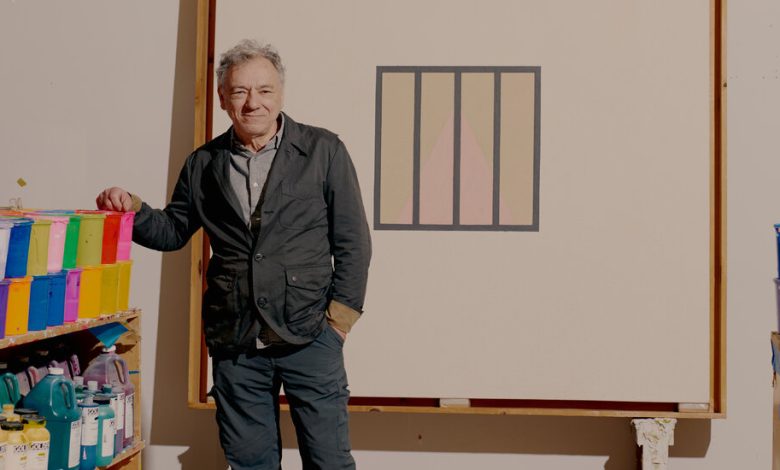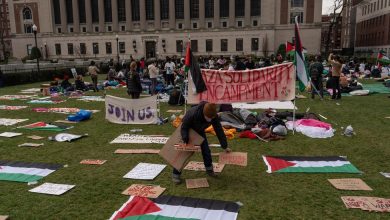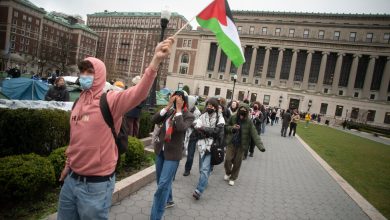40 Years Later, The Return of Halley’s Day-Glo Comet

The colors of a Peter Halley painting are assaultive — lurid hazmat oranges and jaundiced yellows nearly blinding in their acid-dipped fluorescence. And that’s before the dread creeps in, the suspicion that despite being connected in innumerable ways, each of us has never been more alone. In the 1980s Halley devised a simple vocabulary: cells and conduits, rendered in a queasily unnatural palette and precise geometric space, that cut to the heart of a nascent computer age whose byproduct was intensifying social isolation. It turned out that moment never really ended.
Seen today, Halley’s paintings of the ’80s, with their hermetic chambers tethered to the outside world by data lines, have a premonitory quality, anticipating the total triumph of the digital revolution. “A lot of younger people give me credit for that,” Halley told me, sitting in his West Chelsea studio in late winter, a half dozen assistants busy organizing paintings set to depart for Mudam, the Luxembourg museum, and Maruani Mercier, the gallery in Brussels, where half of a four-site retrospective of his work from that decade was set to open.
Did he surprise himself? “It seemed sort of inevitable to me, that human communication was moving onto the electromagnetic spectrum,” he told me. “I was struggling with the first manifestation of that phenomenon — just like, sitting alone in front of a computer.”
Halley, who is 69 and wiry, was born and raised in New York City, but displays none of its abrasiveness, a quality he transferred into his pictures. He speaks softly in a flat, even tone that masks his arid sense of humor. His paintings may not be happy, but they are funny, like parodies of Modernism — Mondrian sendups, the color fields of Josef Albers exposed as prisons, cheerful in their malignancy. His earliest ones were titled with a deadpan moroseness: “The Grave” (1980), “The Imagination of Disaster” (1981), “No Man’s Land” (1986), their hard lines mapping out the claustrophobia of cities, strip malls and apartment blocks. “The misty space of Rothko is walled up,” Halley wrote in 1982, by way of manifesto.

“Untitled,” 1981.Credit…via Peter Halley, Karma, and Craig F. Starr
Having returned to New York in 1980 after completing his M.F.A. at the University of New Orleans, Halley was living in the East Village, showing in that neighborhood’s influential artist-run gallery scene, first at International with Monument, and later at Sonnabend Gallery in SoHo, where in 1986 his diagrammatic representations of modern life were part of the seismic “Neo-Geo” show (for neo-geometric conceptualism) with Ashley Bickerton, Jeff Koons and Meyer Vaisman.
Despite its acclaim, Halley’s cool, rigorous conceptualism has historically been better received in Europe. “People there tend not to be afraid of my paintings,” Halley offered. “I’ll see a picture of one in someone’s beautiful, modernist, monochromatic house. I do get a big kick out of that.”
That affinity is reflected in the Mudam and Maruani Mercier exhibitions. Smaller selections figure at Craig F. Starr and Karma galleries in New York, opening April 27. Taken together, they find an artist who landed upon his idea and never tired of it, or perhaps the revelation of a theory that’s yet to be disproved.
Initially Halley was responding to a dark period of cultural and political life — the election of Ronald Reagan, a recession, renewed threat of nuclear war — and many of his paintings of this period deploy hot, irradiated shades that pulsate anxiously. Halley includes the lusty thrall of Neo-Expressionism — the heavily-brushed art of Basquiat, Julian Schnabel, and Francesco Clemente — among these cataclysms. To him they represented “a celebration of the artist as an extraordinary individualist and virtuoso.”
“So much of what I had grown up with, whether it was Warhol or a minimalist, was the artist as every person,” he said, adding, “I think Warhol created art that anyone could have made, and I guess I still think that’s what an artist does. Or should do.”
Halley considers Warhol a personal hero, and models much of his career after his strategies: repetition, taking the hand out, “embracing ideas that may not make any sense.” He met Warhol twice, once at a dinner for David Salle at Mr. Chow, and once at the Factory’s final iteration in the old Con Ed building on Madison Avenue, in 1986. Reflecting on the experience later, Halley wrote, “it’s completely strange to think about meeting someone you’ve thought about every day for 15 years.”
Warhol photographed Halley for a portrait, which Halley recalls as an oddly sexual experience: “He used the Big Shot camera, and sort of rocked back and forth as he took the picture. It was like being very gently humped.” He likes to point out that his portrait, a double exposure that makes him seem to vibrate with thought, is hung over his studio’s toilet.
Halley’s dedication to the conceptual bend of his practice can feel extreme, at once overly cerebral and naïve. “I grew up with the idea of the artist’s oeuvre as based on a thought experiment,” Halley said, adding, “So much of the art that I was interested in, in the ’60s and ’70s, was based on a premise that nobody else would in their right mind pursue. I think about these cells and prisons as aligned with that experiment, which I think has almost disappeared from contemporary art.”
Still, Halley’s paintings are not totally devoid of psychodrama. They’re a kind of self-portraiture: Holed up in his apartment and reading French post-structuralists like Jean Baudrillard and Michel Foucault, Halley created works that memorialized his melancholy, a square trapped in a square.
Halley rarely concedes this idea, and is generally reluctant to talk about himself. He grew up in an apartment on East 48th Street and Third Avenue, where his parents moved in 1956 when it still belonged to a low-rise neighborhood. His father, a lawyer, died when Peter was three.
Halley’s neatly ordered architectural space comes from tracing the distinctly New York experience of being lonesome while surrounded by eight million people. While in New Orleans in the late 1970s, Halley realized this feeling was not exclusive to New York’s grid. He became interested in the tracts of new construction, particularly in the suburbs, connected only by highways. “It seemed like life on a settlement on another planet,” he said.
New Orleans is also where he first encountered Roll-A-Tex, the fake stucco of motel-room popcorn ceilings, available in hardware stores. The ersatz wall texture, a simulation straight out of Baudrillard, spoke to him as a way to join his geometry to architecture, his craggy cells appearing in low relief against their background.
And then there’s the Day-Glo. Halley’s application of a factory-produced rainbow plumbed its sinister possibilities, linking it with the uneasy feeling that contemporary life was being mediated, drifting further from nature. He wanted to make paintings out of color “that you would never see looking out at the Grand Canyon.”
“Day-Glo paint not only did that but produced a kind of technologically-generated light, almost like an LED screen,” he said. “It’s been a big relief since the iPhone came out, because it’s changed people’s expectations of glowing color. And my paintings look a lot better on a phone than in print.”
From 2002 to 2011, Halley served as the director of the M.F.A. Painting program at the Yale School of Art — ironic, considering he was turned down from the school’s studio art program as an undergraduate. (“It was very traditional, and I just wouldn’t draw still lifes,” he says. He studied art history instead.) He takes pride in the artists in his program, his face brightening as he rattles off a dozen names: Titus Kaphar, Tala Madani, Njideka Akunyili Crosby and Mary Reid Kelley among them.
Madani, who was at Yale from 2004 to 2006, told me that Halley was less interested in proselytizing his vision than in getting students to defend theirs.
“I don’t think he at all changed his opposition to even a lot of the art forms of his students, maybe even including mine,” she continued. “But the plurality of the things that turn him on are really interesting, given the narrowness of his practice. I do think he actually, literally gets lit up.”
Halley is in fact an adept critic, and in the ’80s wrote extensively about the era’s developments in art. From 1996 to 2005 he published Index magazine with the critic and curator Bob Nickas, which was like a lo-fi extension of Warhol’s “Interview.”
“The art world in New York in the early ’90s was really depressing,” Halley said. Index was consciously not an art magazine. “One of my ideas in writing about art is: People would say Picasso was influenced by Cézanne, but he was probably just as influenced by going to the movies; that what you do as an artist is influenced by other media.”
In the mid-1990s, Halley began creating entire rooms bathed in overwhelming color, which make the current “immersive experiences” seem dull by comparison. But his geometry has remained more or less constant, with a few exceptions. A recent body of work at Karma’s Los Angeles gallery featured Halley’s prisons and cells piled precariously as separate canvases knitted together, as if metastasized, but absent their familiar conduits. Circulating bands recede into the background, the connections imperceptibly enmeshed. As a progression of visual language, it almost doesn’t count.
“I think there’s humor in the insistence of his form,” Madani said. “There’s a tragic comedy, it’s like this sick joke — all the things he was rejecting, the political and economic situation that he was responding to in the ’80s, is even more prevalent, so why would he change now? That’s the tragedy, that we haven’t found a better way.”
Halley has this idea that “artists have things they can’t get rid of, like Guston always used pink and gray. It feels a little bit like throwing all the elements up into the air. I’m approaching 70, and it kind of gives you a certain feeling of freedom. That you can get away with it.”




